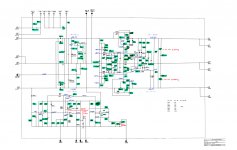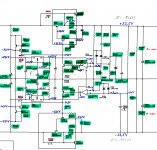Gentlemen,
please find attached the schematic of a dual 32 V series regulator
for a "High End" preamp.
The diagram conforms more or less to existing known solutions.
In my opinion the regulator is inherently unstable. In the actual
set up I see oscillation of about 700 kHz - more on the negative
rail (about 500 mVpp) than on the positive (300 mVpp).
At the moment I am not sure about the best way to tame this nasty
oscillation which shows up at the amp output also - I think the stages
are clean, only badly driven by the supply.
Original .tif picture of crazy 90 MB had to be resized and so it is not
possible to read the designations any more. Not sure about the maximum
file size here.
please find attached the schematic of a dual 32 V series regulator
for a "High End" preamp.
The diagram conforms more or less to existing known solutions.
In my opinion the regulator is inherently unstable. In the actual
set up I see oscillation of about 700 kHz - more on the negative
rail (about 500 mVpp) than on the positive (300 mVpp).
At the moment I am not sure about the best way to tame this nasty
oscillation which shows up at the amp output also - I think the stages
are clean, only badly driven by the supply.
Original .tif picture of crazy 90 MB had to be resized and so it is not
possible to read the designations any more. Not sure about the maximum
file size here.
Attachments
Last edited:
You get a list of maximum file sizes when you add an attachment. The maximum file size depends on the file type. By the way, .png is often more compact than .jpg.
What oscillation frequency do you get without C320 and C322?
If we call that frequency f1, does it help when you place them back with the values changed into C320 = 1/(sqrt(2)*pi*f1*22000 ohm) and C322 = 1/(sqrt(2)*pi*f1*33000 ohm)?
If we call that frequency f1, does it help when you place them back with the values changed into C320 = 1/(sqrt(2)*pi*f1*22000 ohm) and C322 = 1/(sqrt(2)*pi*f1*33000 ohm)?
There's a couple of interconnected things here, it seems that the neg reg depends (also) on the pos reg and vice versa. A first step is to get each reg run on itself, and see if the reg on itself is stable, if not, fix that first.
Try to run the pos reg on itself, see how that works.
Jan
Try to run the pos reg on itself, see how that works.
Jan
Jan, here is only one pos. reference and the neg. rail is adjusted to the pos. rail by gain of -1.
C322 is not used "n. b.".
I know the abbreviation n. m. for not mounted, what does n. b. stand for?
In any case, then you only need to disconnect C320 to determine the oscillation frequency without C320 and C322.
Problem resolved. It was a bad interaction between the amp and supply.
Oscillating sub-regulators LM317, LM337 in small plastic transistor case,
only used for dc servo op-amps, triggered this nasty oscillation of the main
series regulators. Found a way to stabilise the regs. It is however hard to
fix an existing device without changing the intended topology. Redesign of
this big preamp is not useful and will not be paid.
The phenomenon was also level (relay attenuator and gain change) and
temperature dependent (the amp runs hot).
"N. b." may be something like "niet bezet". Thank you for your attention.
Oscillating sub-regulators LM317, LM337 in small plastic transistor case,
only used for dc servo op-amps, triggered this nasty oscillation of the main
series regulators. Found a way to stabilise the regs. It is however hard to
fix an existing device without changing the intended topology. Redesign of
this big preamp is not useful and will not be paid.
The phenomenon was also level (relay attenuator and gain change) and
temperature dependent (the amp runs hot).
"N. b." may be something like "niet bezet". Thank you for your attention.
It is interesting to know what "a way" was to get the regs stable in this unknown unnamed high end preamp. As usual an issue is common in a whole series of that device so other members may benefit knowing what the issue is in their device. Sharing = caring.
Sometimes the way things are asked with only scarce information given does remind someone of the working of a diode.
Sometimes the way things are asked with only scarce information given does remind someone of the working of a diode.
Last edited:
Agreed. The OP asked us to spend some time to help him/give ideas. It is only fair to tell us what the actual solution was so we all can learn.
Jan
Jan
Jan, here is only one pos. reference and the neg. rail is adjusted to the pos. rail by gain of -1.
I realize that 🙂 but is it a potential source of instability.
Jan
Jean and Jan, I disagree.
- The preamp is of "minimal production run" only, the company is still
in existence and I am not allowed to share. In this context it would be
of no use for others, although the amp schematic itself is interesting.
- I asked nobody for help.
- All time spent here is by one's own choice and no obligation to read
and reply.
- I told what the solution was in post 10. It would have been even more
complicated to have a look at the whole device and I was not aware of
additional complications at the time of posting.
- Looking back you will see that most what I post here is free repair help.
- The preamp is of "minimal production run" only, the company is still
in existence and I am not allowed to share. In this context it would be
of no use for others, although the amp schematic itself is interesting.
- I asked nobody for help.
- All time spent here is by one's own choice and no obligation to read
and reply.
- I told what the solution was in post 10. It would have been even more
complicated to have a look at the whole device and I was not aware of
additional complications at the time of posting.
- Looking back you will see that most what I post here is free repair help.
So the product with issues is made by a company that does not allow to share (share what exactly? Brand name, schematics, the issue?) but have their product buyers searching for fixes on a hobby forum? 🙂 Nice.
Normally audio consumers/technical abled people are at the same side of the line when an issue occurs in whatever device and are issues/cures shared instead of protecting the manufacturer.
Normally audio consumers/technical abled people are at the same side of the line when an issue occurs in whatever device and are issues/cures shared instead of protecting the manufacturer.
Last edited:
It are your own posts that leave things to interpretation. Also some simple logic: why would an owner of a problematic (probably expensive) device not name the device type name/number and not mention the manufacturer? For a repair tech counts the same. That could indicate the company itself or one of its technicians searches for a remedy for the issues 😉 Or that the device is vintage and no one ever found the issue nor a solution.
Anyway for the members here is would be very good to know what the brand/type number of this high end "minimal production run" preamp is so we can avoid obtaining one (or replicate your found remedy to solve issues if one of our audio friends has one).
Anyway for the members here is would be very good to know what the brand/type number of this high end "minimal production run" preamp is so we can avoid obtaining one (or replicate your found remedy to solve issues if one of our audio friends has one).
Last edited:
+1Good, I'll make sure never to reply to any thread started by you anymore.
ROFL.
A tribute to irreproducible experiments.
Good, I'll make sure never to reply to any thread started by you anymore.
Yes. The ignore list is my friend.
Nobody asked him to divulge anything about the company or the product. He had an issue with a regulator, has published here the schematic, has fixed it, and refuses to tell us the fix. Clearly, the issue was the result of a stupid error of him he is too embarrassed to mention. Very childish.
Jan
Last edited:
- Home
- Amplifiers
- Power Supplies
- Series Regulator Oscillation

